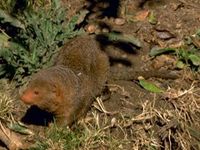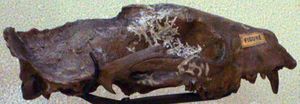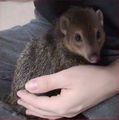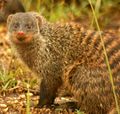نمس
| Mongoose | |
|---|---|
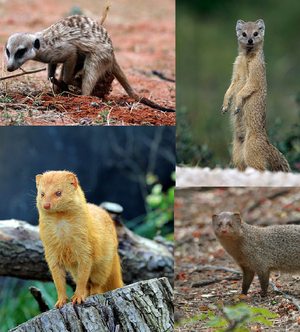
| |
| Top left: Meerkat Top right: Yellow mongoose Bottom left: Slender mongoose Bottom right: Indian gray mongoose | |
| التصنيف العلمي | |
| أصنوفة غير معروفة (أصلحها): | الحياة |
| مملكة: | الحيوانية |
| Phylum: | حبليات |
| Class: | الثدييات |
| تحت رتبة: | سنوريات الشكل |
| الفصيلة: | سموريات Bonaparte, 1845 |
| Type genus | |
| Herpestes | |
| Genera[1] | |
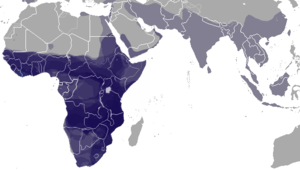
| |
| Synonyms[1] | |
|
قائمة
| |
النمس (أو المنكوز Mongoose) حيوان ثدي من فصيلة السنوريات رتبة آكلات اللحوم, طويل الجسم يستطيع مقاتلة الأفاعي وأكلها, يوجد في العراق بمدينة كركوك وفي منطقة أحراش باباكركر على وجه الخصوص جلبه الإنكليز الأوائل الذين أتوا للبحث والعمل على النفط وذلك للقضاء على الأفاعي بالمنطقة للتخلص من شرها, حيث جلبوه من الهند وأستوطن المنطقة وتكاثر فيها.
وهناك أكثر من أحد عشر جنسا من النموس تضم أكثر من 400 نوعا تعيش في العالم القديم أشهرها النمس الهندى الرمادي اللون .
وتبلغ فترة حياة النمس من 7 الى 12سنة وتلد أنثاه من 3 الى 4 صغار .
أُدخل النمس إلى جامايكا، وكوبا، وبورتوريكو، وهاواي، وبعض أجزاء أخرى من العالم لغرض قتل الفئران. وعلى أية حال، فإن النمس في حالات كثيرة قد أهلك العديد من الطيور الأليفة، مقارنة بما فعله للجرذان. ولهذا السبب، لا يمكن إدخال النمس في أقطار عديدة بدون ترخيص.
الوصف
يتميز النمس الهندي بذيل طويل له نفس طول الجسم تقريبا ، الرأس صغير ، والأذن صغيرة ، والأنف مستدق ، والقوائم قصيرة ينتهي كل منها بخمسة أصابع مزودة ببراثن بارزة
يبلغ طول النمس قرابة المتر بما في ذلك الذيل ويزن نحو تسعة كيلو جرامات . يعيش فرادى او في جماعات صغيرة أثناء الصيد وأثناء موسم التزاوج ويقطن البيئات الشجرية والعشبية والحقول الزراعية ويتسلق الأشجار بسهولة
، ويهاجم المناطق المأهولة بالسكان ويسطو على الطيور الداجنة . يسكن الجحور الأرضية التي يحفرها بنفسه وفي التلال الضخمة التي يبنيها النمل الابيض . وهو شديد الحذر حيث انه نادرا مايخرج من بين الحشائش والأعشاب الى الاراضي المكشوفة لأكثر من لحظات قصيرة .
وأكثر ما اشتهر به النمس قدرته على قتل الثعابين، ليس لأن لديه مناعة ضد السم؛ ولكن لسرعته التي تساعده على قبض الثعابين السامة مثل الكوبرا وقتلها. ويقتل النمس أيضاً الفئران، والجرذان والدواجن، والطيور البرية وبعض الحيوانات الصغيرة الأخرى. كما يأكل أيضاً بيض الطيور.
التشريح
يشبهه ابن عرس
حياته
صراعه مع الأفاعي
يشتهر النمس ببراعته ومهارته في القضاء على الأفاعي السامة، ويرجع السبب في ذلك الى سرعته الفائقة ورشاقته ، إذ يغرس أسنانه الحادة التي تشبه رؤوس الإبر في عنق الأفعى بعد مراوغات معها ينتصب خلالها شعر الجسم والذيل جميعه ويبدو النمس ضعف حجمه . كما أن الذنب ينتصب ويتحول الى فرشاه قاسية يحك بها وجه خصمه حتى ان ناب الأفعى يعجز عن التأثير على هذه الحزمة من الشعر . ويذكر انه ليس لدى النمس حصانة ضد سم الأفاعي ، لكنه غالبا لايعطيها الفرصة للدغه ، ولديه بعض المقاومة للسم. وعلى الرغم من شراسة النمس إلا انه إذا إستأنسه الإنسان صغيرا ، فإنه يصبح أليفا ويتحول الى حيوان مدلل لعوب .
التغذية
التكاثر
العلاقة مع الإنسان
التصنيف
Herpestina was a scientific name proposed by Charles Lucien Bonaparte in 1845 who considered the mongooses a subfamily of the Viverridae.[2] In 1864, John Edward Gray classified the mongooses into three subfamilies: Galidiinae, Herpestinae and Mungotinae.[3] This grouping was supported by Reginald Innes Pocock in 1919, who referred to the family as "Mungotidae".[4]
Genetic research based on nuclear and mitochondrial DNA analyses revealed that the Galidiinae are more closely related to Madagascar carnivores, including the fossa and Malagasy civet.[5][6] Galidiinae is presently considered a subfamily of Eupleridae.[7]
| Subfamily | Genus | Species | Image of type species |
|---|---|---|---|
| Herpestinae | |||
| Herpestes Illiger, 1811[8] |
|
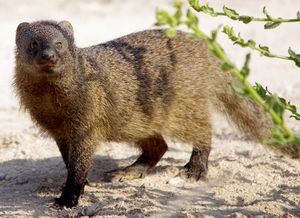
| |
| Atilax Cuvier, 1826[14] | Marsh mongoose (A. paludinosus) (Cuvier, 1829)[15] | 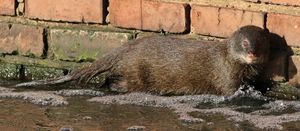
| |
| Cynictis Ogilby, 1833[16] | Yellow mongoose (C. penicillata) (Cuvier, 1829)[15] | 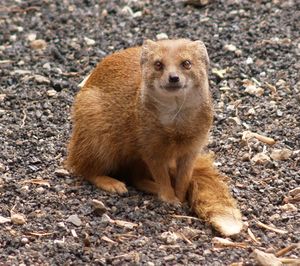
| |
| Urva Hodgson, 1836[17] |
|
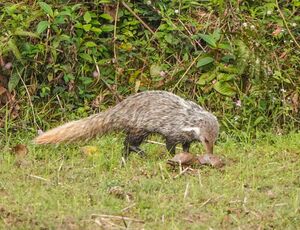
| |
| Ichneumia Geoffroy Saint-Hilaire, 1837[23] | White-tailed mongoose (I. albicauda) (Cuvier, 1829)[15] | 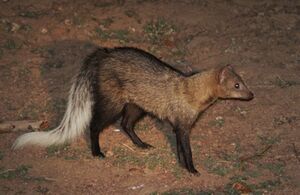
| |
| Bdeogale Peters, 1850[24] |
|
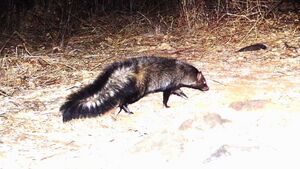
| |
| Rhynchogale Thomas, 1894[30] | Meller's mongoose (R. melleri) Gray, 1865[3] | 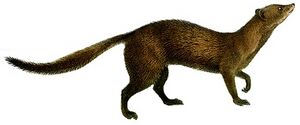
| |
| Paracynictis Pocock, 1916 | Selous's mongoose (P. selousi) (de Winton, 1896) | 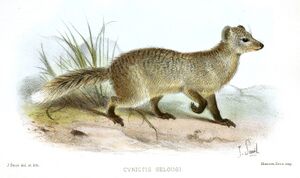
| |
| Xenogale Allen, 1919[31] | Long-nosed mongoose (X. naso) (de Winton, 1901)[32] | 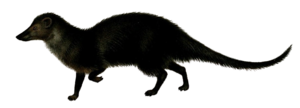
| |
| Mungotinae | Mungos E. Geoffroy Saint-Hilaire & F. Cuvier, 1795[33] |
|
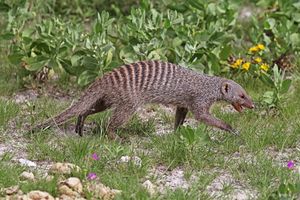
|
| Suricata Desmarest, 1804[36] | Meerkat (S. suricatta) (Schreber, 1776)[37] | 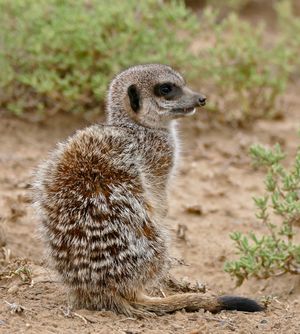
| |
| Crossarchus Cuvier, 1825 |
|
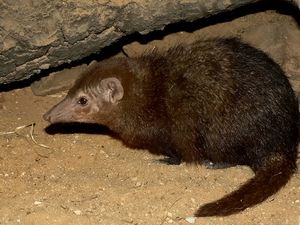
| |
| Helogale Gray, 1861 |
|
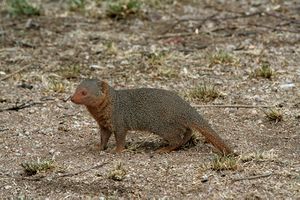
| |
| Dologale Thomas, 1920 | Pousargues's mongoose (D. dybowskii) Pousargues, 1894[38] | 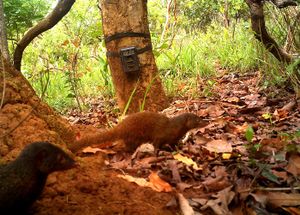
| |
| Liberiictis Hayman, 1958 | Liberian mongoose (L. kuhni) Hayman, 1958 |
Phylogenetic relationships
Phylogenetic research of 18 mongoose species revealed that the solitary and social mongooses form different clades.[39] The phylogenetic relationships of Herpestidae are shown in the following cladogram:[40][41]
| Herpestidae |
| ||||||||||||||||||||||||||||||||||||||||||||||||||||||||||||||||||||||||||||||||||||||||||||||||||||||||||||||||||||||||||||||||||||||||||||||||||||||||||||||||||||||||||||||||||||||||||
Extinct species
- †A. mesotes Ewer 1956
- †H. lemanensis Pomel, 1853
Leptoplesictis Major, 1903[42]
- †L. atavus Beaumont, 1973
- †L. aurelianensis Schlosser, 1888
- †L. filholi Gaillard, 1899
- †L. mbitensis Schmidt-Kittler, 1987
- †L. namibiensis Morales et al., 2008
- †L. peignei, Grohé et al., 2020
- †L. rangwai Schmidt-Kittler, 1987
- †L. senutae Morales et al., 2008
معرض الصور
Mongoose, or Mangouste as depicted in the 1851 Illustrated London Reading Book
Long-nosed Cusimanse, Crossarchus obscurus
Banded Mongoose, Mungos mungo
النمس المقدس
اعتقد المصريون القدماء ان النمس حيوان مقدس حتى اسموه فأر فرعون وذلك لإبقائه على اعداد التماسيح عند حد معين في نهر النيل ، إذ كان يتغذى على بيضها . وهناك أسطورة تقول أن النمس قد يتسلل الى فم التمساح ويتعدى البلعوم والحنجرة ليمزق أحشاءه ويصل الى القلب ليمزقه ويأكله.
حاسة السمع وصيد الفرائس
يتمتع النمس بحاسة شم قوية جدا ، ويستشعر الروائح من بعيد ويحس بحركة الهواء باتجاه العدو . وتمنحه حاسة الشم القدرة على ااستكشاف مواقع الشقوق والحفر والقنوات ومعرفة ما بداخلها من فرائس .
يتغذى النمس على الجرذان والفئران والسقايات والحشرات والحيوانات الصغيرة والحبوب والثمار ، إلا أنه شديد الولع بأكل البيض . وتصيد النموس فرائسها بين الحشائش والنباتات القصيرة . وتبقى على اتصال مع بعضها من خلال صوت سقسقه مستمرة كالطيور .
تساعد معيشة النمس في البيئات الشجرية القريبة من القرى والهجر والمدن وتنوع غذاءه على حمايته وتقليل فرص تعرضه لخطر الإنقراض.
تشتهر ذكور النموس بعراكها العنيف فيما بينها ، إذ يتشابك النمسان كالقطط البرية مستعملة الأسنان والكفين كأسلحة تتشابك حتى يبدو وكأن كل منهما يمزق الآخر مع إصدارهم لصراخ عال ، لكن المعركة غالبا تنتهي من غير إصابة أحدهما بسوء وقد أدخل النمس الى نيوزيلندة وجزر الهند الغربية لمكافحة الأفاعي والجرذان ، إلا انه أحدث تدهورا خطيرا في التنوع البيولوجي بقضائه على أنواع محلية كثيرة . لذلك تمنع الكثير من الدول إدخاله اليها كالولايات المتحدة وكندا .
الفائدة
لولا نشاط النمس والعرسة لارتفع معدل تكاثر الجرذان في العالم فهذان الحيوانان يأكلان الفئران ويتغذيان عليها ويخلصان العالم من ( شرورها ) خارج معامل العلماء.
وإذا كان النمس Herpestinae sp (Mongooes)
المصادر
- ^ أ ب قالب:MSW3 Carnivora
- ^ Bonaparte, C. L. (1845). "Fam. VII. Viverridae". Catalogo Methodico dei Mammiferi Europei. Milan, Italy: L. di Giacomo Pirola. p. 8.
- ^ أ ب Gray, J.E. (1865). "A revision of the genera and species of viverrine animals (Viverridae) founded on the collection in the British Museum". Proceedings of the Zoological Society of London: 502–579.
- ^ Pocock, R. I. (1919). "The classification of mongooses (Mungotidae)". The Annals and Magazine of Natural History. 9 (3): 515–524. doi:10.1080/00222931908673851.
- ^ Yoder, A. D.; Burns, M. M.; Zehr, S.; Delefosse, T.; Veron, G.; Goodman, S. M.; Flynn, J. J. (2003). "Single origin of Malagasy carnivora from an African ancestor". Nature. 421 (6924): 434–437. Bibcode:2003Natur.421..734Y. doi:10.1038/nature01303. PMID 12610623. S2CID 4404379.
- ^ Flynn, J. J.; Finarelli, J.; Zehr, S.; Hsu, J.; Nedbal, M. (2005). "Molecular phylogeny of the Carnivora (Mammalia): Assessing the Impact of Increased sampling on resolving enigmatic relationships". Systematic Biology. 54 (2): 317–337. doi:10.1080/10635150590923326. PMID 16012099.
- ^ Wilson, D.E.; Reeder, D.M., eds. (2005). Mammal Species of the World: A Taxonomic and Geographic Reference (3rd ed.). Johns Hopkins University Press. ISBN 978-0-8018-8221-0. OCLC 62265494.
{{cite book}}: Invalid|ref=harv(help) - ^ Illiger, C. (1815). "Überblick der Säugethiere nach ihrer Verteilung über die Welttheile". Abhandlungen der Königlichen Preußischen Akademie der Wissenschaften zu Berlin. 1804−1811: 39−159.
- ^ Linnaeus, C. (1758). "Viverra ichneumon". Caroli Linnæi Systema naturæ per regna tria naturæ, secundum classes, ordines, genera, species, cum characteribus, differentiis, synonymis, locis. Vol. Tomus I (Decima, reformata ed.). Holmiae: Laurentius Salvius. p. 41. (in لاتينية)
- ^ Rüppell, E. (1835). "Herpestes sanguineus. Rüppell". Neue Wirbelthiere zu der Fauna von Abyssinien gehörig. Frankfurt am Main: S. Schmerber. pp. 27–28.
- ^ Wagner, J.A. (1839). "Über die Verwandtschafts-Verhältnisse der Pharaonsratte". Gelehrte Anzeigen der Königlich Bayerischen Akademie der Wissenschaften zu München. 9 (183): 425–429.
- ^ Gray, J.E. (1848). "Description of a new species of Herpestes, from Abyssinia". Proceedings of the Zoological Society of London (November): 138–139.
- ^ Bocage, J.V.B. (1889). "Mammifère d'Angola et du Congo". Jornal de Sciencias mathematicas, physicas e naturaes. 2. 1: 174–185.
- ^ Cuvier, F. G. (1826). "Vansire". In E. Geoffroy Saint-Hilaire; Cuvier, F. G. (eds.). Histoire Naturelle des Mammifères : avec des figures originales, coloriées, dessinées d'aprèsdes animaux vivans. Tome 5. Paris: A. Belin. p. LIV.
- ^ أ ب ت Cuvier, G. (1829). "Les Mangoustes. Cuv. (Herpestes, Illiger)". Le règne animal distribué d'après son organisation, pour servir de base à l'histoire naturelle des animaux et d'introduction à l'anatomie comparée. Paris: Chez Déterville. pp. 157–158.
- ^ Ogilby, W. (1833). "Characters of a new Genus of carnivorous Mammalia from the collection of Mr. Steedman". Proceedings of the Zoological Society of London (Part 1): 48–49.
- ^ أ ب ت Hodgson, B. H. (1836). "Synoptical description of sundry new animals, enumerated in the Catalogue of Nepalese Mammals". Journal of the Asiatic Society of Bengal. 5: 231–238.
- ^ أ ب Geoffroy Saint-Hilaire, É. (1817). "De l'Ichneumon. Ichneumon pharaon". In Jomard, E. F. (ed.). Description de l'Égypte, ou, Recueil des observations et des recherches qui ont été faites en Égypte pendant l'éxpédition de l'armée française. Vol. Tome II. Paris: Commission des Sciences et Arts d'Egypte. pp. 137–144.
- ^ Bennett, E. T. (1835). "Remarks on some Mammalia from Travancore, including a New Species of Herpestes". Proceedings of the Zoological Society of London. III: 66–67.
- ^ أ ب Gray, J. E. (1837). "Description of some or little known Mammalia, principally in the British Mueum Collection". The Magazine of Natural History and Journal of Zoology, Botany, Mineralogy, Geology and Meteorology. I (November): 577–587.
- ^ Waterhouse, G. R. (1838). "On two new species of Mammalia, from the Society's collection, belonging to the genera Gerbillus and Herpestes". Proceedings of the Zoological Society of London. VI: 55–56.
- ^ Gray, J.E. (1846). "New species of Mammalia". The Annals and Magazine of Natural History; Zoology, Botany, and Geology. 18 (118): 211–212.
- ^ Geoffroy Saint-Hilaire, I. (1837). "Notices sur deux nouveaux genres de Mammifères carnassiers, les Ichneumies, du continent Africain, et les Galidies de Madagascar". Annales des Sciences Naturelles. 2. 8: 249–252.
- ^ Peters, W. (1850). "Bdeogale". Sitzungsberichte der Gesellschaft Naturforschender Freunde zu Berlin: 94.
- ^ Peters, W. (1852). "Mittheilung über die in Mossambique beobachteten Mangusten". Verhandlungen der Königlich Preussischen Akademie der Wissenschaften zu Berlin: 81–82.
- ^ Pucheran, J.P. (1855). "Les Mammifères de la côte occidental d'Afrique". Revue et magasin de zoologie pure et appliquée. 2. 7: 111.
- ^ Thomas, O. (1894). "On a new African Genus of Mustelidae". The Annals and Magazine of Natural History; Zoology, Botany, and Geology. 6. 13 (78): 522–524.
- ^ Heller, E. (1914). "New antelopes and carnivores from British East Africa". Smithsonian Miscellaneous Collections. 61 (2240): 1–15.
- ^ Foley, C. & Do Linh San, E. (2016). "Bdeogale omnivora". IUCN Red List of Threatened Species. 2016: e.T136686A45221619.
- ^ Thomas, O. (1894). "On the mammals of Nyasaland: third contribution". Proceedings of the Zoological Society of London (February): 136–146.
- ^ Allen, J. A. (1919). "Preliminary notes on African Carnivora". Journal of Mammalogy. 1 (1): 23–31. doi:10.2307/1373716. JSTOR 1373716.
- ^ de Winton, W. E. (1901). "Description of a New Mongoose from West Africa". Bulletin of the Liverpool Museums Under the City Council. 3 (2): 35–37.
- ^ Geoffroy, E. & Cuvier, F. (1795). "Mémoire sur une nouvelle division des Mammifères, et sur Ies principes qui doivent servir de base dans cette sorte de travail, lu à la société d'Histoire naturelle, le premier floréal de l'an troisième". In Millin; Noel & Warens (eds.). Magasin Encyclopédique : ou journal des sciences, des lettres et des arts. Vol. Tome second. Paris: I'lmprimerie du Magazin Encyclopédique. pp. 164–189.
- ^ Gmelin, J. F. (1788). "Viverra mungo". Caroli a Linné, Systema naturae per regna tria naturae, secundum classes, ordines, genera, species, cum characteribus, differentiis, synonymis, locis. Vol. I (13th aucta, reformata ed.). Lipsiae: Georg Emanuel Beer. pp. 84–85.
- ^ Ogilby, W. (1835). "Descriptions of Mammalia and Birds from the Gambia". Proceedings of the Zoological Society of London. Part III: 97–105.
- ^ Desmarest, A. G. (1804). "Genre Surikate, Suricata Nob.". In Deterville, J. F. P. (ed.). Nouveau dictionnaire d'histoire naturelle appliquée aux arts : principalement à l'agriculture et à l'économie rurale et domestique. Vol. 24. Paris: Deterville. p. 15.
- ^ Schreber, J. C. D. (1776). "Viverra suricata". Die Säugethiere in Abbildungen nach der Natur, mit Beschreibungen. Erlangen: Expedition des Schreber'schen Säugthier- und des Esper'schen Schmetterlingswerkes. p. CVII.
- ^ de Pousargues, E. (1894). "Description d'une nouvelle espèce de mammifère du genre Crossarchus et considérations sur la répartition géographique des crossarques rayés". Nouvelles Archives du Muséum d'Histoire Naturelle. 3 (in الفرنسية). 6: 121–134.
- ^ Veron, G.; Colyn, M.; Dunham, A.E.; Taylor, P.; Gaubert, P. (2004). "Molecular systematics and origin of sociality in mongooses (Herpestidae, Carnivora)". Molecular Phylogenetics and Evolution. 30 (3): 582–598. doi:10.1016/S1055-7903(03)00229-X. PMID 15012940.
- ^ Barycka, E. (2005). "Evolution and systematics of the feliform Carnivora". Mammalian Biology. 72 (5): 257–282. doi:10.1016/j.mambio.2006.10.011.
- ^ أ ب ت Patou, M.; Mclenachan, P.A.; Morley, C.G.; Couloux, A.; Jennings, A.P.; Veron, G. (2009). "Molecular phylogeny of the Herpestidae (Mammalia, Carnivora) with a special emphasis on the Asian Herpestes". Molecular Phylogenetics and Evolution. 53 (1): 69–80. doi:10.1016/j.ympev.2009.05.038. PMID 19520178.
- ^ "Creodonta and Carnivora from the Early Miocene of the Northern Sperrgebiet, Namibia". Memoir of the Geological Survey of Namibia. 20: 291–310. 2008.
{{cite journal}}: Cite uses deprecated parameter|authors=(help)
قراءات أخرى
- Rasa, Anne (1986). Mongoose Watch: A Family Observed. Garden City, NY: Anchor Press/Doubleday & Co.
- Hinton, H. E.; Dunn, A. M. S. (1967). Mongooses: Their Natural History and Behaviour. Berkeley: University of California Press.
{{cite book}}: Unknown parameter|lastauthoramp=ignored (|name-list-style=suggested) (help)
- Articles with لاتينية-language sources (la)
- CS1 الفرنسية-language sources (fr)
- CS1 errors: deprecated parameters
- Short description is different from Wikidata
- Use dmy dates from April 2020
- Automatic taxobox cleanup
- CS1 errors: unsupported parameter
- حيوانات
- حيوانات مفترسة
- سنوريات
- ثدييات في أفريقيا
- ثدييات من آسيا
- Marathi terms
